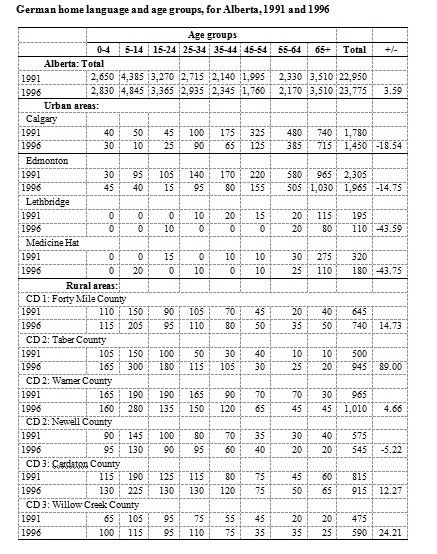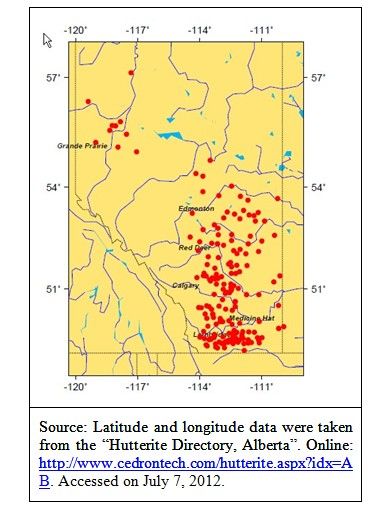
German language maintenanceIntroductionGerman as a mother tongue. After the immigration boom in the 1950s and 1960s, the number of Albertans who reported German as their only mother tongue reached almost 100,000 between 1961 and 1971; subsequently it dropped to ca. 78,000 in 2001, increased again by some 6,000 individuals to 84,505 five years later and then declined once more to ca. 81,000 persons in 2011; see the table below for the numbers of single and multiple (i.e., German and one or more other languages) responses. 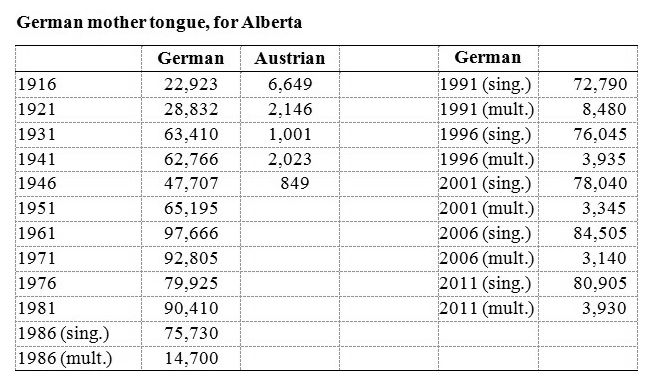 German as a home language. The extent to which a language is used in the home is most likely the best indicator of its vitality. The language first acquired (mother tongue) may be abandoned in the early years or during young adulthood; if a person has a "knowledge of an unofficial language" or uses it "at work", as defined by the census, the extent and frequency of its use is subject to wide interpretation (Every day? Ten minutes a day? With just a few customers?). By comparison, the criterion "used most often in the home" is a much more clearly defined parameter. If German is reported to be used by a person - a child, a youngster or an adult - most often in the home it is indeed a "living" language. If a child grows up speaking and hearing German in the home and is encouraged to continue to use it at home s/he is likely to acquire a good competence in the language, which gives a person the confidence to use it. Given the right conditions, such a person is then also more likely to raise his or her children with German in the home. No doubt there is still substantial language loss from one generation to the next in such a case, but it is almost certainly less than in those families where the parents report their child to be growing up with German as the first language "learned," but not really exposed to it in the home. Of course, this voluntary surrender of the parent's language may occur for many good and acceptable reasons. Regrettably, an analysis of the status of German as a home language is complicated by the fact that the census authorities have changed the question as well as the manner in which the responses were tabulated several times, making it virtually impossible to compare the numbers for a given locality over time. For this reason most data will be presented as "snapshots in time". In 1971, there were almost 30,000 Albertans who used German as their home language (see Table below). Ten years later, in 1981, the census reported 27,485 Albertans who spoke only German at home. In 1991 22,950 persons spoke only German at home; 2,805 more individuals reported German as one of their home languages. In 2001 the census reported 11,110 Albertans who spoke only German at home and another 14,505 who spoke German "mostly" at home. In 2006 there were 32,520 individuals who said that they spoke "most often" German at home. In 2011 the census reported 35,490 Albertans who spoke German "most often at home", and another 18,190 spoke German "regularly" in the home environment.  Notes: 1. The Census recognized that the number of multiple responses was significantly higher than five years before. This was said to be due to changes in the question, to the way in which the population answered it, or an increase in the number of persons reporting a multiple response, or a combination of the three. 2. Because of differences in the way in which home language data were collected and categorized in 1996 and 2001, respectively, these two data sets are not comparable (see introductory chapter, Section 2.6.1ff.). For the purposes of this investigation, only two categories are reported in this table: Using a certain language (viz. German) "only" or using it "mostly." Consequently, the reader will only be able to get an impression of the size of the group reporting speaking "only" or "mostly" German as their home language in 2001. It is not possible to state whether the use of German as a home language in a given locality rose or fell or remained the same over the period from 1996 to 2001. 3. Language spoken "most often" at home. The 2006 census did not provide details as to which other language was spoken "regularly" at home; the categories were only "none", "English", "French", "non-official language", "English and French", "English and non-official language", "French and non-official language" and "English, French and non-official language". 4. Language spoken most often at home. Language spoken regularly at home (English: 17,910, other non-official languages, such as French (N=65), Russian (N=55), Spanish (N=25), Dutch (N=15), Hungarian (N=15), etc.). The data appear to suggest that the use of German as a home language among Albertans has risen strongly. However, there is a caveat: It will be shown below that the distribution of speakers of German as a home language differs markedly between the rural and urban regions of the province.
This divergent development in the use of German as the language of the home can be explained by the fact that in the urban areas German as a mother tongue (and therefore as a home language) has been virtually lost in the post-immigrant generations while in certain rural areas German is being maintained as a mother tongue and home language, and because of the large number of children growing up in these areas, the number of German home language users has risen quite dramatically. Data substantiating this statement will now be presented. [1] In the following, data from the 2006 Census will first be used below to illustrate the differential development of the numbers of German mother tongue speakers in urban versus rural areas. Where available, 2011 census data will be employed to update the numbers and observations. German as a mother tongue and home language in 2006: Urban vs. rural areasThe following graph for Alberta as a whole shows the continued aging of Albertans with German mother tongue on one hand, and an increase in the - already very high - number of children with German mother tongue between 2001 and 2006 on the other hand. It could be concluded that German as a mother tongue everywhere in the province is in a very healthy state; however, this graph is deceptive and does not tell the whole story. 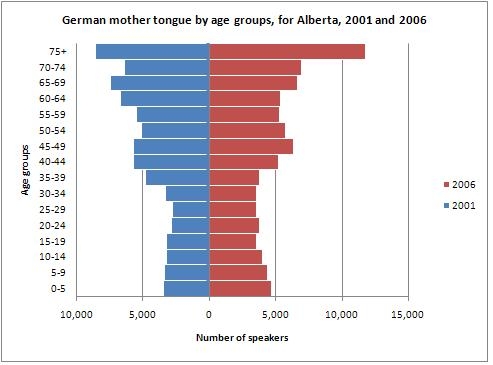 German in the urban areasCompare the same graph with the data for Calgary below. It shows an inverted pyramid with very few children in the lower age groups learning German as their first language and very large numbers of older Calgarians with German mother tongue, clearly the immigrant generation. 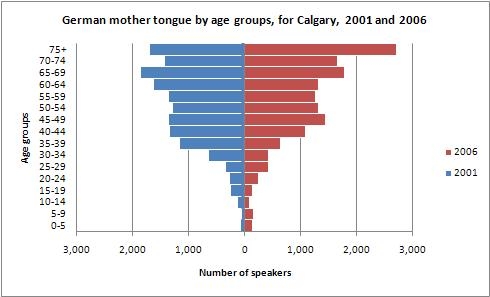 The distributions for Edmonton and Medicine Hat shown in the graph below are very similar. In Edmonton there were 205 and 265 children in the below 5 and 5-10 year age groups, resp., while in Medicine Hat no children in these age brackets were reported to learn German as their first language. 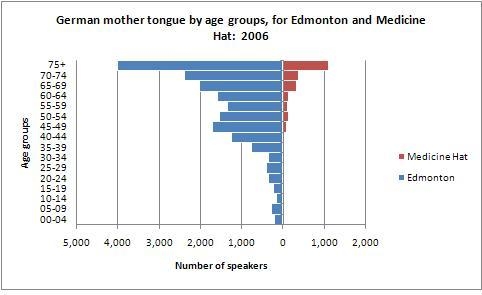 Plotting the data for other urban centers like Lethbridge, Red Deer or Wetaskiwin shows the same distribution. In other words, the immigrant generation with German mother tongue is passing away, and there are few children in the urban areas who are learning German as their first language. The slight increase in the number of children in Calgary and Edmonton in the 2006 Census can be explained by recent increases in the number of German-speaking immigrants from Germany, Poland and other countries with German-speaking minorities. Note also that the Alberta and Federal Governments, together with German-speaking organizations such as the German-Canadian Business and Professional Association of Alberta, have made determined - and successful - effforts to attract qualified workers from Germany from ca. 2005 on. The following graph contrasts the number of Calgarians reporting to have learned German as their mother tongue and actually using it at home in 2006. Note the dramatically rising number of Calgarians with German mother tongue as distributed over the age groups while the number of those who are using German at home remains small. Calculating the language maintenance ratios (= persons who are using German as their home language as a percentage of the total number of those reporting to have learned as their first language) is instructive: For the very small children the ratio is relatively high (45%) - but, after all, it is the parents who are reporting the extent of use of German at home! In the 5-9 year age group the percentage drops to 25%, then further to 24%. Only 15% of the 15- to 19-year-olds speak German as their most frequently used language in the home. The language maintenance ratio declines to less than ten percent in the 35-39 year age group and only rises to 13% with Calgarians 75 years of age and above. Given this low language maintenance rate in the cities and towns, there will soon be very few speakers with German as a home language in these localities. 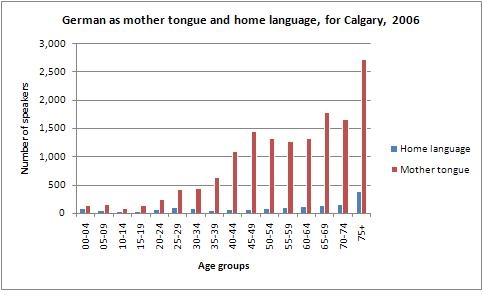 The most recent - reasonably comparable - detailed data on German as a home language (1991 and 1996) in the table below confirm this hypothesis:
German in the rural areasAs can also be seen from the above table, the linguistic situation is pronouncedly different in areas of the province with large numbers of Hutterites (click here for more detail on the Hutterites) and certain groups of Mennonites (click here for more details). There, German as a mother tongue and a home language is flourishing. German among the HutteritesTake, for example, Forty Mile County in the southeastern corner of the province, just southwest of Medicine Hat. In 2006, it had a population of 3,410 of whom 740 persons reported German as their mother tongue. The following graph shows that in that county there were 150 children up to the age of 5 and another 160 between five and nine years of age who had German as their mother tongue; the higher age brackets form a pyramidal shape with relatively few older individuals with German mother tongue. Similarly, in Lethbridge County, there were 200 children in the lowest age bracket and 155 between 5 and 9 years of age; otherwise the same shape of the population pyramid prevailed. 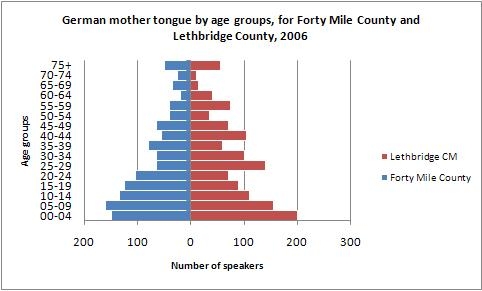 Similar population distribution patterns are encountered in Warner County (located just west of Forty Mile County along the border with the U.S.) where 1,385 persons out of a total county population of 3,645 had German as their mother tongue. In Wheatland County (just east of Calgary) 1,360 individuals out of 8,110 reported German mother tongue. 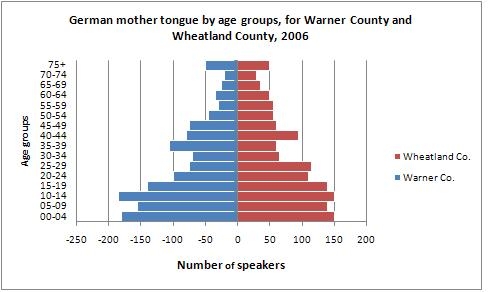 In Cardston County, there were 1,115 persons with German mother tongue, in Willowcreek County there were 870, in Vulcan County 855. And so on. These are the areas where many of the Hutterite colonies in Alberta are located (click here for a detailed description of the Hutterites). In the 2001 Census, most of the altogether 12,330 Hutterites resided in the following areas of the province: 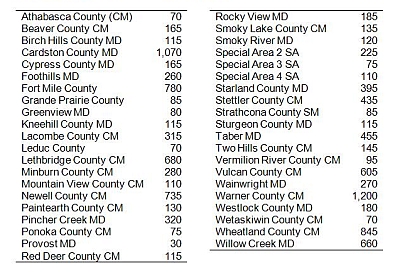 The following map shows the locations of Hutterite colonies.
German among the MennonitesIn their faith, the Mennnonites are quite diverse; they range from relatively secular urban residents to very conservative groups living by choice in remote areas of the province (click here for a detailed description of the Mennonites). Many Mennonites in Alberta speak German, but not all, of course, do: In 1991, 10,145 Mennonites of the ca. 22,000 Mennonites in Alberta—less than half—said that they had acquired German as their mother tongue. As a matter of fact, in the traditionally Mennonites localities, such as Coaldale, Hanna, Tofield and Linden, no children were reported to grow up with German as their mother tongue in the last census, and there were no children in these places who were learning German as their home language. On the other hand, the Mackenzie MD in northern Alberta - in particular La Crete and its surroundings where conservative Mennonite groups (especially Old Colony Mennonites) have re-migrated from South America in recent years (the 2001 Census found 4,790 Mennonites) - presents a different picture. In 1996, 4,385 persons in that MD stated that they had learned German as their mother tongue and 3,740 indicated that they used German as their home language. By 2001, the number of residents of the Mackenzie MD with German mother tongue increased to 5,395; five years later the census recorded 6,515 individuals. According to the 2001 Census, 22,790 Mennonites lived in Alberta - an increase by two percent between 1991 and 2001; ten years later, the Mennonites numbered 24,550 persons. In 2001, almost one quarter of the Mennonites resided in the cities like Calgary (3,590) and Edmonton (1,525), but were otherwise spread out over the entire province (see table below). Large numbers of mostly conservative Mennonites have settled in the north of the province near Fort Vermilion and La Crete (e.g., in the Mackenzie MD) and in the Grande Prairie region near the Alberta-B.C. border (e.g., Clear Hills MD, East Peace MD and Greenview MD). East of Edmonton, Mennonites live in towns such as Tofield and Stettler, and in central Alberta there are large numbers of Mennonites in towns and villages such as Beiseker, Didsbury and Linden. Other localities with large concentrations of Mennonites can be found in southwestern Alberta (e.g., in Lethbridge, Pincher Creek, Coaldale, Taber and north to Vauxhall) and southeastern Alberta (Medicine Hat and north to Duchess, Rosemary and Gem). 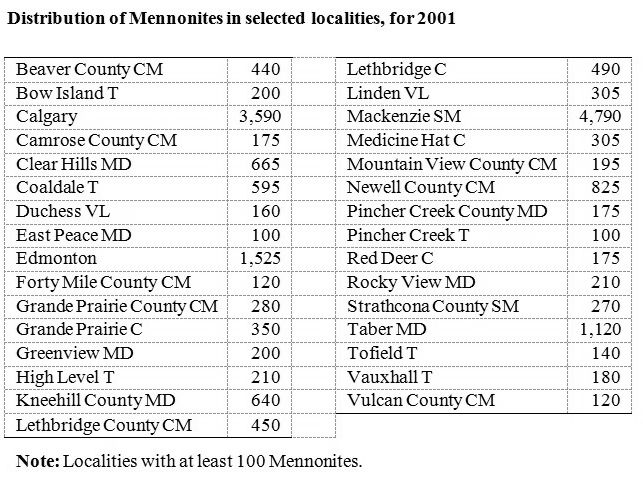 The Mennonites' age profile. The age distribution of Mennonites is strongly skewed in favour of the younger age groups: In 1991, 6,640 Mennonites were children below the age of 15; there were 3,790 persons between the ages of 15 and 24 and another 6,860 between 25 and 44; 3,405 ranged in age between 45 and 64, and 1,630 Mennonites were older than 64. According to the 2001 Census, almost one third of Alberta's Mennonites were children below the age of 15; another 15% ranged in age between 15 and 24. Ten years later, the age distribution for young Mennonites displayed the same percentages. 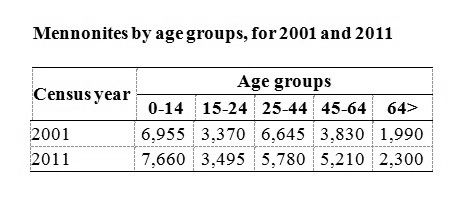 The following graph shows the age distributions of persons with German mother tongue in Mackenzie MD in the very northwest corner of the province (most of them living in and in the surrounding areas of La Crete) and in the Clear Hills MD south of it and bordering British Columbia. Mackenzie has a total population of 9,925 persons of whom 6,515 claim German as their mother tongue. In Clear Hills, 1,010 persons of altogether 2,720 inhabitants reported German as the first language learned in the 2006 Census. The very large numbers of children growing up with German as their first language are notable. Additional hundreds of German mother tongue speakers reside in adjacent MDs of Northern Lights MD (N=150) and Big Lakes MD (N=150).  The Mennonite settlement in and around La Crete goes back to 1932 when Old Colony Mennonites left Saskatchewan to found a new colony in the Peace River area in northern Alberta. The settlement at La Crete grew to a membership of 130 by 1950, with additions of dissatisfied families coming from Mexico. Members of the Bergthaler and Sommerfelder Mennonite groups followed. From the 1990s on, Mennonite immigrants from Bolivia arrived in this area. Conservative Mennonites had also settled in the Lethbridge and Taber areas, and with the re-migration from Mexico from the mid-1990s on large numbers arrived there. An Edmonton Journal article (July 23, 1995) reported that at that time 1,000 Mexican Mennonite families resided in southern Alberta; between January and July 1995, 136 Mexican Mennonite families were reported to have come to southern Alberta, many of them settling in towns and villages like Duchess, Vauxhall, Rosemary and Taber. Because there are also many Hutterite colonies in this area of southern Alberta, it is not possible to display age distributions for locations settled by Mennonites only. The following graph displays distributions in the MD of Taber and the Town of Taber. While the MD shows the typical distribution of German mother tongue speakers, the Town of Taber has relatively large numbers of very young as well as older speakers of German. One may speculate that the distribution reflects the composition of the large, extended Mennonite families immigrating from Mexico and elsewhere.  Mennonite immigration. The 2011 National Household Survey reported that of the 24,450 Mennonites 1,375 arrived between 2001 and 2005 and another 1,215 between 2006 and 2011. Because the NHS did not report on all localities, but only census metropolitan areas and census agglomerations, it is difficult to tell where the immigrants went. Of those listed in the survey 245 came to the Lethbridge CA (=census agglomeration) between 2001 and 2011 and 50 to the Medicine Hat CA; another 90 arrived in Calgary, Edmonton, Okotoks and Camrose CMAs in the same time period. This leaves 2,200 Mennonites who came to Alberta in that decade unaccounted for by this table focussing only on the larger centers and ignoring the rural areas. It should also be remembered that among the 18,890 non-immigrants many will have resided in Alberta for a long time, while others who had emigrated to Central and South America and never gave up their Canadian citizenship were not counted as immigrants. The following table shows the number of immigrants from Central America (including Mexico) to the MD of Taber over four different time periods. 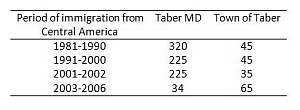 The following graph uses 2011 census data to show the number and distribution of persons with German mother tongue in Mackenzie County and in Calgary. It illustrates what is likely to happen with German as a mother tongue in Alberta. 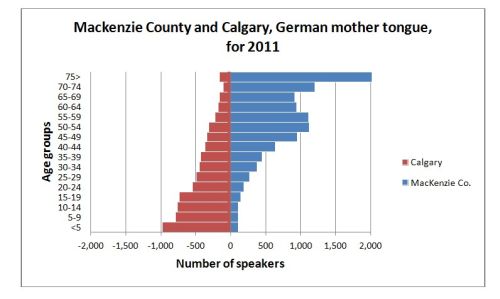 ObservationsThe maintenance of German as a mother tongue and home language is quite different among the Hutterites and conservative Mennonites when compared to children and youths in the urban areas who very frequently do not use German as the language in the home although they had grown up with it as their first language: They live in often remote, encapsulated communities and have relativly little contact with the outside world; the children's access to the outside world via mass media such as radio, TV and the internet is extremely restricted or not available at all. And, most importantly, the German language plays a crucial ideological role in these communities because it is the language in which their faith is grounded. In both Hutterite and conservative Mennonite communities, children are taught German so that they may be able to read and understand the Bible, and German is the normal language of communication in the home. While many Hutterite colonies have an "English teacher" who teaches the Alberta curriculum and often also offers classes in standard German, some of the very conservative Mennonite groups maintain their own schools and follow a curriculum which has frequently been a source of conflict with the Alberta Department of Education. While it is true that some of the re-immigrant Mennonites - especially in southern Alberta - are learning English, are working in the community and are picking up secular habits, there is still a strong attachment to the German language. German also continues to be a significant language in the workplace among the Hutterites and in a number of Mennonite settlements in rural areas in northern and southern Alberta that have recently experienced the in-migration from Bolivia and Mexico, respectively. Of the 27,550 Albertans who used German as their home language in 2001, 12,330 were Hutterites and 5,360 were residents of the heavily Mennonite Census Division 17 in northern Alberta, and there were hundreds more Mennonites using German as their home language in the northern Census Divisions 18 and 19 and elsewhere in the province! This leaves maybe 5,000 Albertans with German mother tongue who speak German in the home; most of them are likely to belong to the higher age groups. The graph below compares the number of Albertans using German as the language spoken most often in the home with the distribution of Calgarians using German as their mother tongue; the distribution for Edmonton is similar. This graph speaks more loudly than a thousand words. 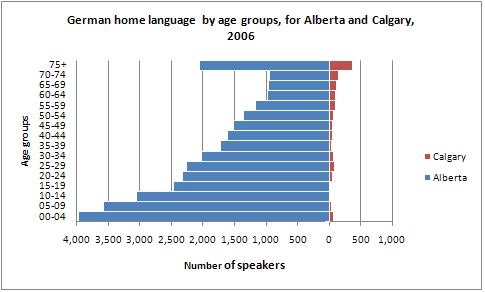 Alberta's Hutterites and Mennonites must, of course, be congratulated for the linguistic vitality of their communities. It is the "traditional" German-speaking community in Alberta that will continue to lose visibility in society at large. Some people will consider this development disturbing and regrettable although linguistic and cultural assimilation in an open society is a virtual certainty among most ethnocultural groups. Conceptualizing the linguistic vitality of German in AlbertaIt would be an exaggeration to speak of "language death," but there can be no doubt that German in Alberta's urban areas is seriously lacking in vitality. Sociolinguists and other scholars have tried to conceptualize the process of "language endangerment". Wurm, for instance, has suggested the following "levels of language endangerment" in the context of language shift [2]: 1. decreasing use of the language by children (potentially endangered language); Using these categories, German must certainly be considered a "seriously endangered language" in most urban areas of Alberta, and even a "moribund language" in some. Among the more liberal Mennonite groups, the state of linguistic vitality of German ranges between "seriously endangered" and "extinct." Among the conservative Mennonites and the Hutterites, the German language, of course, enjoys good health. Another perspective on the issue of linguistic vitality involves conceptualizing the kind of assimilation that a language group is undergoing over time. Kloss, in one of the first such attempts, suggested three types of assimilation [3]:
1. immediate assimilation, which takes place already in the immigrant generation; In this scenario, most post-war immigrants have been subject to "organic assimilation" as evidenced by the large number of children of German-speaking immigrants learning German in Canadian public schools, colleges and universities from the 1960s through the 1980s. True, in many cases, assimilation was "immediate", but then at the other end of the spectrum German has become entrenched "permanently" among conservatives Mennonites and the Hutterites. Based on J.W. Berry's work with a psychological acculturation model, Richard Y. Bourhis developed a bidimensional model of acculturation. He proposed that immigrants must confront two basic issues, viz. whether or not the immigrant culture is of value and should be retained, and whether it is desirable to adopt the language and culture of the dominant majority. [4] • The integrationist orientation reflects a desire to maintain key features of the linguistic and cultural identity while adopting aspects of the majority culture, including the dominant language. Bourhis continued to develop the model by suggesting an interaction between "linguistic and acculturation orientations adopted by the immigrant and national minorities, the linguistic and acculturation orientations adopted by the dominant majority towards specific linguistic minority groups and interpersonal and intergroup relational outcomes which are the product of combinations of linguistic minority and dominant majority acculturation orientations." [5]. This model takes account of the expectations and pressures exerted by the dominant culture and of intergroup relations rather than focussing on the immigrants' orientation alone. According to this model, most post-war immigrants from Germany and other countries subscribed to an integrationist or assimilationist orientation; a few might have felt "marginalized" (providing motivation for returning to Germany, which many immigrants did, in fact). Some persons with high self-esteem may have followed an individualist strategy in positioning themselves in Canadian society. Certain religious groups, such as conservative Mennonite groups and the Hutterites, may have employed (and may still do so) a separatist strategy by voluntarily segregating themselves from secular society. Prokop [6] has suggested three patterns of approach to the preservation and cultivation of the German language and culture, which may be functionally characterized as follows: Type A: Regular and serious participation in various ethno-cultural and social events to “preserve” the German heritage in the family and the province; preservation of a “German” life style and system of values in the home; use of German as the main language of communication in the home and the church by the older and the younger generation; a deliberate seeking-out of the company of other speakers of German just because they are German; formation of a “German island” amidst the anglophone culture, where the stated intention is to pass on German language and culture to the next generation, and members consider themselves to be “German” or “German-Canadian” with strong German background. With this approach, traditional German culture and language will survive beyond the present generation. Type B: Occasional participation in ethno-cultural activities for nostalgic enjoyment and social mingling; immigrant parents may speak German to each other and to the children when they are still young, but they give up eventually and switch to English when talking with them; the children use English among themselves; parents and children follow an increasingly Canadian life style and do not want to appear “different’; the parents may have German-speaking friends, but do not seek them out deliberately; the older members consider themselves “German-Canadian” or “Canadians of German origin,” but the younger members perceive themselves primarily as “Canadian.” In this pattern, the German cultural and linguistic heritage will not survive beyond the immigrant generation. Type C: Virtually no participation in ethno-cultural activities; the immigrants give up German as the home language very quickly, even among themselves; they adopt the Canadian life style and system of values completely; the children are raised as anglophone Canadians for whom German culture is something that was left behind in Europe; if they have German-speaking friends, this is a coincidence; the members of this group consider themselves Canadians. With this approach to the preservation of language and culture, the cultural heritage is being abandoned. Conservative Mennonites and Hutterites could be said to follow a Type A approach to assimilation. No doubt, there were many post-war immigrants in the urban areas as well who tried to raise their children in a German linguistic and cultural environment. These children often turned out to be perfectly bilingual and had—and many still have—a strong affinity to their roots. In most immigrant families, however, the parents made sincere attempts to teach their children German and to cultivate German culture and traditions at home and were quite persistent initially. But over time, it became easier for all concerned to use German at home and permit their children to respond in English (Type B assimilation). In few immigrant families where both parents had acquired German as their mother tongue, the language was surrendered right away. But where an immigrant got married to a member of another ethnic group who did not speak any German, the language was not used at all at home or only tentatively. In some cases, such families would send their children to a private German-language school for a while. If the children’s resistance became too strong German would disappear more and more from the family’s consciousness (Type C assimilation). Are "the Germans" the only ones who appear to surrender their linguistic heritage so readily? By no means; the German-language groups differ only little from the other traditional immigrants like the Ukrainians and the Scandinavians. The following table shows the strong sense of belonging to their ethnic or cultural group displayed by the more recent immigrant groups from Asia: 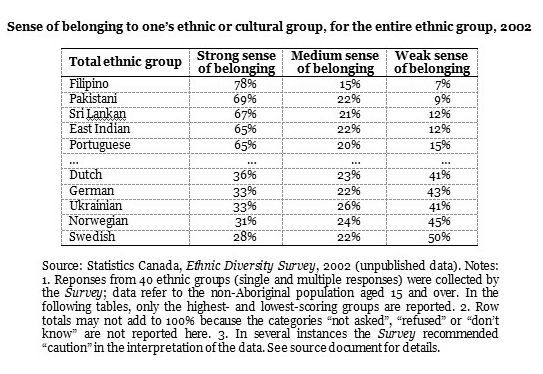
Clearly, recency of immigration plays a significant role. And yet: Note the relatively weak sense of belonging displayed by immigrants of German origin who arrived during the 1990s: Only 50% of them said in 2002 that they felt a strong sense of belonging to the German group or German culture! 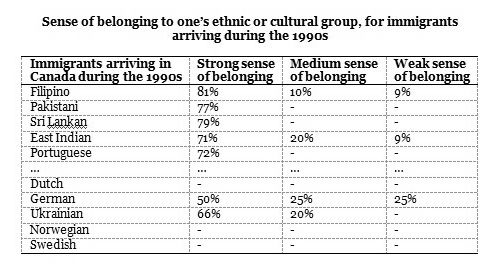
Pondering possible reasons for the "death of the German language" in urban AlbertaIt has been shown elsewhere in great detail [7] that “the Germans” in urban Canada have demonstrated a considerable readiness to abandon their ancestral language and that immigrants from Germany feel “right at home” in Canada very quickly; many give up German as the language of the home and perceive themselves as German-Canadians, rather than as Germans, very soon after their arrival in Canada. Compared to some other ethnic groups, “the Germans” use their ancestral language less frequently in the second and third generations (where the language is lost, to all intents and purposes), and they restrict their use of German to the family and a circle of close friends. It is true that the attitude towards the retention of German expressed by parents (especially recent immigrants who are still fluent in the language) with regard to the desirability for their children to learn and maintain German has been very strong, but this stated attitude has not necessarily been translated into practice in real life. Clearly the loss of German as a mother tongue in the immigrant and post-immigrant populations is the result of many different social, cultural, religious, economic and familial factors, and the attempt at an explanation of this complex development applies virtually exclusively to them, NOT to the immigrants since the 1970s. For them, external pressures to give up their "Germanness" do not exist, of course. Factors involved in influencing language maintenance or lossIn a review of the relevant literature Prokop (see [8] for details) has shown that in addition to the - admittedly speculative - sociocultural reasons for language retention (see below), language maintenance in the German ethnic group is influenced by a number of verifiable factors - recency of immigration, rural vs. urban residence, level of education and type of occupation, gender, age, the rate of endogamy and the extent to which German is spoken in the home environment. The findings are summarized in the following. The use of the German language in Canada is strongly related to the recency of time of immigration of its speakers. In an all-Canadian study one third of the immigrants from the Federal Republic of Germany reported that they spoke English as their home language after as little as six months' residence in Canada. Residence in an urban or a rural area has had a significant impact on language maintenance from the time when such issues were first investigated. In 1941 the census found persons residing in the rural areas to be twice as likely not to speak either of Canada's official languages when compared to urban dwellers. The early Canadian censuses explained this difference by the rural dwellers' lack of contact with the English-speaking world and the vastly greater opportunities for an intermingling of ethnic groups with English speakers in the urban areas. This argument still applies, especially so in the communities which encourage a strict separation of their members from the outside world. A similar observation was made for gender differences in language maintenance. In the first half of the 20th century, there were a number of reports that foreign-born females were slower to learn English than males were; this was attributed to the fact that most speakers of German in those days lived in rural areas and had little contact with the outside world, and among them women remained in the home even more of the time than men did. Recent census data show the effect of gender on language maintenance to be small, but in the same direction as previously observed. Another major factor in the retention of German was found to be the level of education. Persons with less than a Grade 9 education showed a rate of language preservation two to three times higher than the rate of preservation of German by persons with any higher level of schooling. The relationship was not linear in nature, however. It is not possible to maintain that the higher the level of formal schooling, the lower the rate of language retention; instead, a plateau appears to be reached with entry into high school, beyond which there are only small differences in language loss and language retention. Once more, the rural/urban distinction made a significant difference: more than twice as many rural than urban residents with less than a Grade 9 education spoke German in the home in 1981. Occupational criteria are clearly a function of educational background: not surprisingly, persons in the primary occupations, such as farming, and in horticultural and animal husbandry occupations, displayed a higher level of language retention than did persons in any other occupational field. Traditionally, rural residents have tended to value formal education less highly than urban residents. - To the present day, certain religious groups, i.e. the Hutterites and conservative Mennonites, do not generally encourage their children to obtain formal schooling beyond the level of compulsory school attendance. Age is another extremely important predictor for language loss or language retention. While some 85% of small children of German origin have been reported to speak German in the home, this rate declines drastically after the age of ten and reaches a plateau of about 25% after the age of 20. Again, the residence criterion plays a major role in determining the rate of language maintenance: across all age groups, the rural residents use German as their home language considerably more frequently than do urban residents: by age 15, some 15% of the urban residents with German background still speak German as their dominant home language; in the country, as many as two thirds claim German to be the first language of the home. An association between the desire to marry within one's own ethnic group (endogamy) and the rate of language preservation was noted frequently as early as the first part of the century. It was determined that "the Germans" tended to select a partner outside their own ethnic group more often than most other ethnic groups. This observation holds still today as about three quarters of men and women of German origin marry partners with a different ethnic background; the rate of endogamy is only slightly higher in rural than in urban areas. The rate of endogamy proves to be a significant factor in determining whether German will be used as the dominant language of the home and, consequently, whether the children will learn German as their mother tongue and the language which they use at home. It was found that the chance for children to acquire German as their mother tongue and as their home language was greatest if both parents spoke German in the home. In one-parent families where the father or the mother was either of German origin, had a German mother tongue, or used German as his or her home language, only a small number of children picked up German as their first language and virtually none learned it long and intensively enough to be able to use it as the home language. In ethnically mixed families where one partner was unable to use German as the home language, virtually no children appeared to acquire German as the mother tongue, or to learn and use it as the dominant home language. This finding is of great relevance because another part of the study carried out by this author determined that the skill level to which a child is brought at an early age predicts very strongly the level at which the youngster is able to function later in life. In particular, those who as small children had reached a level of proficiency in German at which they understood and spoke German freely and spontaneously and also read and wrote German at their level as if they lived in a totally German-speaking environment, retained their original high level of proficiency best. Small wonder that the fluency with which German is spoken by the immigrant generation vs. the second and third generations differs considerably. About two-thirds of the first-generation immigrants perceived themselves to be fluent in the language, but only five percent of the second generation did so and virtually none in the third generation. In Edmonton, about half of the immigrant population claimed to use German every day; only a quarter of the second and a miniscule one percent of the third generation said that they used German every day. The implications of the dramatic language loss among the immigrant and post-immigrant populations are obvious: if fewer children are learning German as their home language, fewer people in the next generation will be able to use German as the home language in endogamous families. Moreover, there will be more families with only one German-speaking partner; at the same time, we know that practically none of the children in ethnically and linguistically mixed families acquire German either as their mother tongue or as the home language. Likely sociocultural reasons for the decline in the use of German in Alberta among the post-war immigrants and their children
OutlookThe effect of the drastic loss of German among the present generation of speakers of German in urban Canada, on the one hand, and the small number of future speakers of German being raised, on the other hand, above all in the cities, has already had profound effects (and will continue to do so) on the type of student taking German at the school and the university level. Enrolments in language schools and public schools have suffered serious declines over the last twenty or thirty years; there seem to be just enough children from German-speaking families to attend the English-German bilingual schools to make them viable; enrolments are shrinking dramatically in most church schools where they still exist. Enrolments in German in junior and senior high schools, colleges and universities have plummeted since the 1980s, and students with non-German background cannot compensate for the decline in the number of those for whom German was part of their family ancestry. It appears inevitable that the German clubs and associations across the province will lose ever more of their membership by death than new members can be added. With the "disappearance" of "the Germans" there will be commercial implications as well as there will be less need for German-speaking pediatricians, gynecologists, doctors, real estate agents, lawyers, delicatessens and so on. But this is not to say that German culture in Alberta —i.e., popular culture—will disappear altogether: There will probably always be a German tent at Heritage Days in Edmonton where thousands of German sausages and sauerkraut will be consumed: During the 2011 Edmonton Heritage Festival the German pavilion was very busy: almost 7,000 bratwursts and portions of Leberkäse (Bavarian meat loaf), 1,600 pieces of applestrudel and more than 2,000 pretzels were sold! Anglophone connoisseurs of fine food will continue to buy their bread and pastry at German bakeries and will discover the delicious flavour of German-style cold cuts and meats. Unfortunately, there will be virtually no one in the beer tents, pastry shops and delicatessens who will be able to speak and understand German. Notes[1] Manfred Prokop, The German language in Alberta. Maintenance and Teaching (Edmonton: University of Alberta Press, 1989), pp. 15-16. [2] Stephen A. Wurm, "Strategies for language maintenance and revival," in David Bradley and Maya Bradley (eds.), Language endangerment and language maintenance (New York: RoutledgeCourzon, 2002), p. 14. [3] Heinz Kloss, "Der sprachenrechtliche Rahmen," in Leopold Auburger, Heinz Kloss and Heinz Rupp (eds.), Deutsch als Muttersprache in Kanada. Berichte zur Gegenwartslage (Wiesbaden: Franz Steiner Verlag, 1977), pp. 53-57. [4] Richard Y. Bourhis, "Acculturation, language maintenance and language shift," in Jetske Klatter-Folmer and Piet Van Avermaert (eds.), Theories on maintenance and loss of minority languages (Münster et al.: Waxmann, 2001), pp. 5-37. [5] Bourhis, p. 24. [6] Manfred Prokop and Gerhard Bassler, German language maintenance across Canada: A Handbook (Edmonton, 2004). [7] Manfred Prokop, "The dynamics of German language maintenance in Canada". Forum Deutsch 16.1 (2008). [8] Prokop (1989), pp. 19-65.
|

